New Horizons Top 10: What We've Learned So Far About Pluto And Its Moons
by Sophia Nasr, @Pharaoness
The New Horizons mission has unveiled the Pluto system with a level of detail previously unattainable. It has confirmed models, refined models, and brought completely new information to the table. Here are 10 things that New Horizons has revealed about the Pluto system.
1: Pluto confirmed as largest Kuiper Belt Object (KBO)
The New Horizons mission determined Pluto’s diameter to be 2370 ± 4 km (1473 ± 2.5 miles). That makes Pluto larger than Eris, which has a diameter of 2326 ± 12 km (1445 ± 7.5 miles). According to Alan Stern, principal investigator for New Horizons, this “settles the debate about the largest object in the Kuiper belt.”
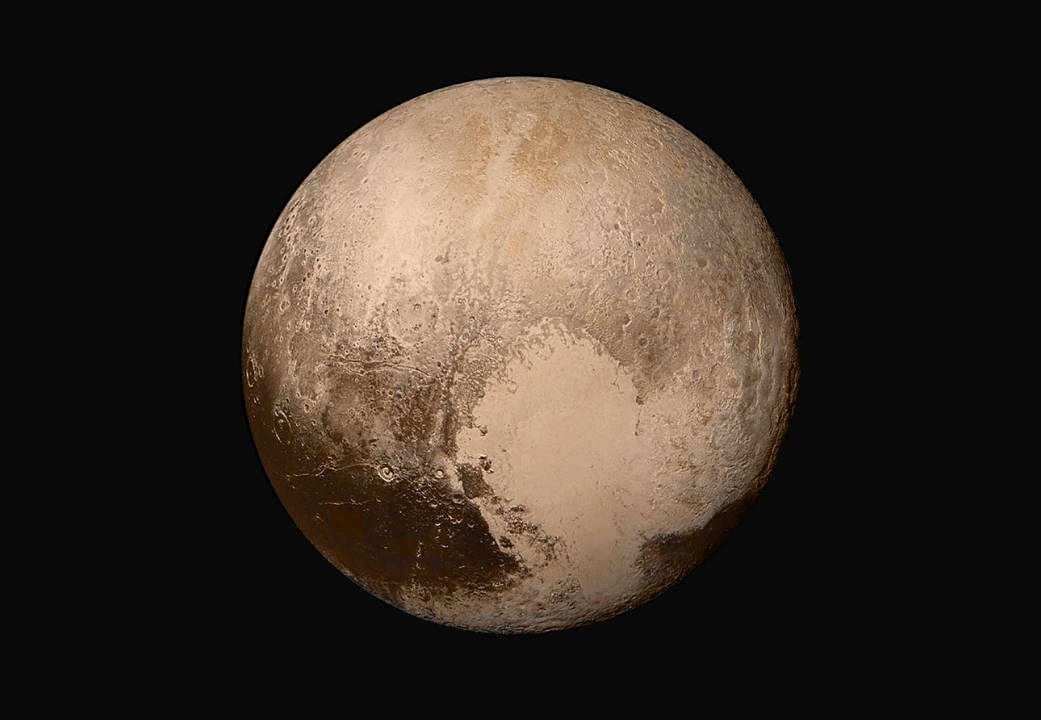
The refined size measurement is higher than previous values, meaning Pluto is slightly less dense, since density is mass per unit volume. This probably means Pluto has more ice in its interior than originally thought, since ice is less dense than rock.
Eris is smaller than Pluto but 30% more massive. Since Eris is also smaller than Pluto it has a higher density. This was always thought to be the case, even with the previous lower estimates for Pluto’s diameter, but now it is even more so. Eris has a density of about 2.5 g/cm3, while Pluto’s density is about 1.9 g/cm3.
2: Pluto’s moon Hydra revealed for the first time
The shape of Pluto’s moon Hydra was recently revealed by New Horizons, and its shape is somewhat like a rubber ducky.

To me, its shape looks similar to that of Comet 67P/Churyumov-Gerasimenko, a comet that's been visited by Rosetta’s lander, Philae. Take a look below and judge for yourself.

You may think that the resolution of the image is pretty low, but before this image was taken, things like Hydra’s shape, size, and reflectivity, were all shrouded in uncertainty. So this image provides us with our first ever good look at Hydra.
3: Charon has a strange "mountain on a moat", and we don’t know what it means yet
In one of the recent close-up photos of a region on Pluto’s largest moon Charon, we see this strange mountain rising out of a depression in the moon’s surface, or a "mountain on a moat". This feature has scientists stumped—they can’t quite explain it! The image can be viewed below.
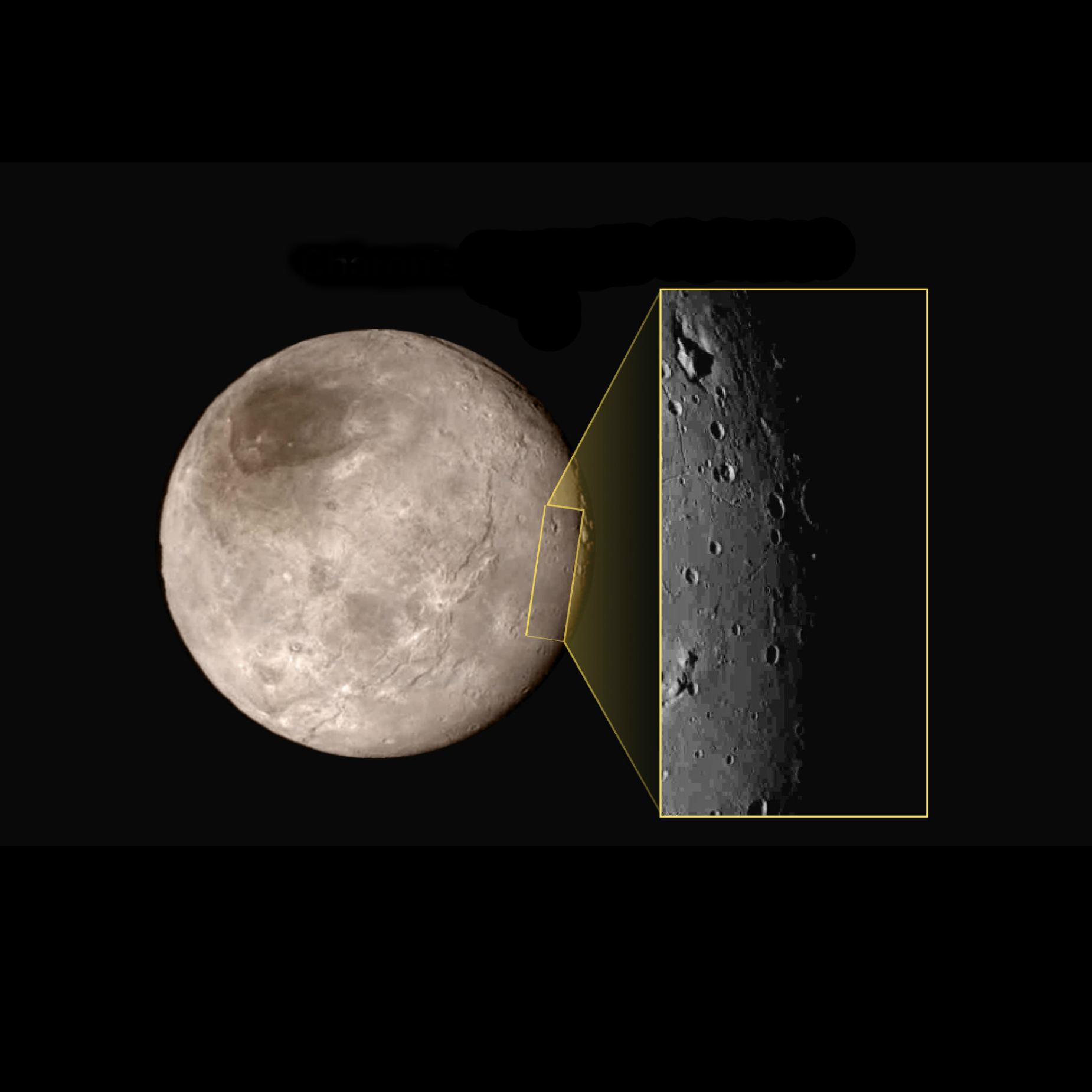
Getting the image to Earth as quickly as New Horizons scientists did came with a price, however—compression of data has produced artifacts in the image. When the full resolution image, along with all the other data, is downlinked, we may get a better idea of what this feature is.
4: Charon has cliffs and troughs, a canyon, and a dark pole
Pluto’s largest moon Charon has brought some surprises to the table, too. For one, this world is rife with cliffs and troughs, extending some 1000 km (600 miles) across Charon’s surface. Another surprise came with the discovery of a very prominent canyon at the upper right of Charon’s edge, a canyon that is some 7 to 9 km (4 to 6 miles) deep. A surface that’s relatively void of cratering, Charon must have undergone some recent geological activity. And its darkened pole, dubbed Mordor (a tribute that makes us die-hard Lord of the Rings fans very happy), appears to be a layer of some type of deposit. You can tell that it's a deposit because you can see the craters in that region are white, revealing the materials beneath the material on the darkened pole. You can view all these features in the image below.

5: Charon doesn’t seem to have much of an atmosphere
While models have indicated that Charon may have an atmosphere, the latest data downlinked from New Horizons on the Charon occultation of the Sun indicate otherwise. If you look at the light curve below, it sharply drops once the sunlight is blocked by Charon, instead of bending and slowly declining, like that of Pluto. Both light curves can be viewed below, so that you can compare the two.

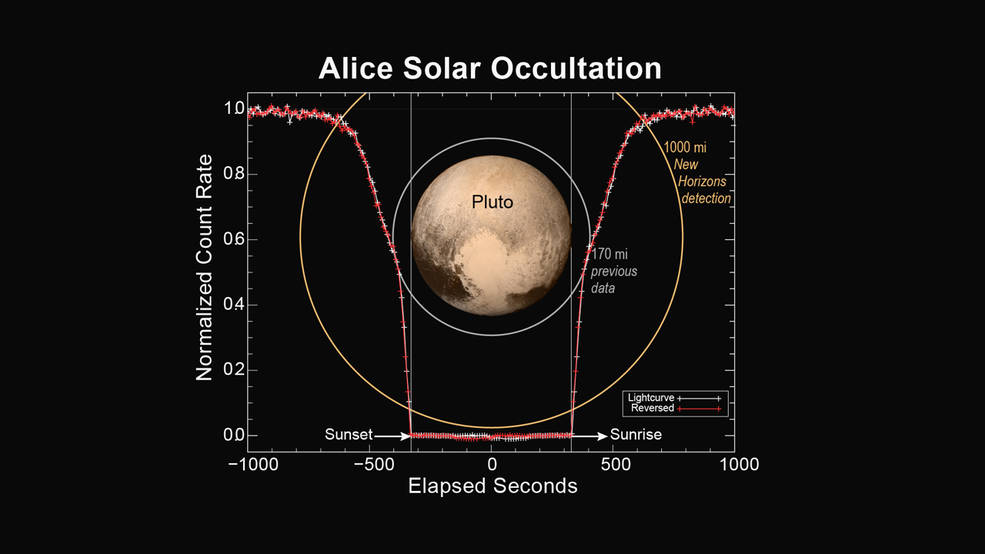
The light curve indicates that Charon barely has any atmosphere at all. However, this was just a taste of the data taken by the Alice instrument; once the full dataset is downlinked, we may find that Charon has some atmosphere, but if so, it is much thinner than that of Pluto.
6: Pluto has an ion tail, and its atmosphere is being stripped away at astounding rates by solar winds
In a stunning discovery, New Horizons scientists revealed that the interactions of the solar wind with Pluto’s outer atmosphere (or exosphere), found to extend to some 1600 km (1000 miles) above Pluto’s surface, gives Pluto an ion tail. Solar winds are basically outflows of energetic particles sent out from the Sun, and these outflows interact with the particles in Pluto’s atmosphere (mainly molecular nitrogen). The region, containing ionized nitrogen, forms a "plasma tail" that extends out from 77,000 km (48,000 miles) to 109,000 km (68,000 miles) from Pluto. A graphic showing what this looks like can be viewed in the image below.

As the solar winds interact with Pluto’s atmosphere, they strip it away, carrying it out into space. The rate at which the atmosphere is being stripped is mind-boggling—500 tons/hour! If you add up all the nitrogen that has been stripped from Pluto over its roughly 4.6-billion-year age, that translates to a layer of nitrogen that’s about 9000 feet thick... Wow.
7: Pluto’s atmosphere has layers of haze
The New Horizons spacecraft recently took an image that provided the first ever look at Pluto’s atmosphere. This was the first time the scientists, and the world, got to actually see Pluto’s atmosphere. What’s most shocking is that the haze layers are actually visible in its atmosphere (you can actually see them in the image below). This image nearly brought the atmospheric scientists to tears.
The hazes are forming much higher in Pluto’s atmosphere than models had previously predicted. Models predicted that the hazes would form close to Pluto’s surface, where temperatures are colder, but instead, the hazes are forming higher in the atmosphere, where temperatures are warmer. The haze particles in Pluto’s atmosphere undergo a process through radiation from the Sun that forms "tholins", which are likely what give Pluto its reddish hue.
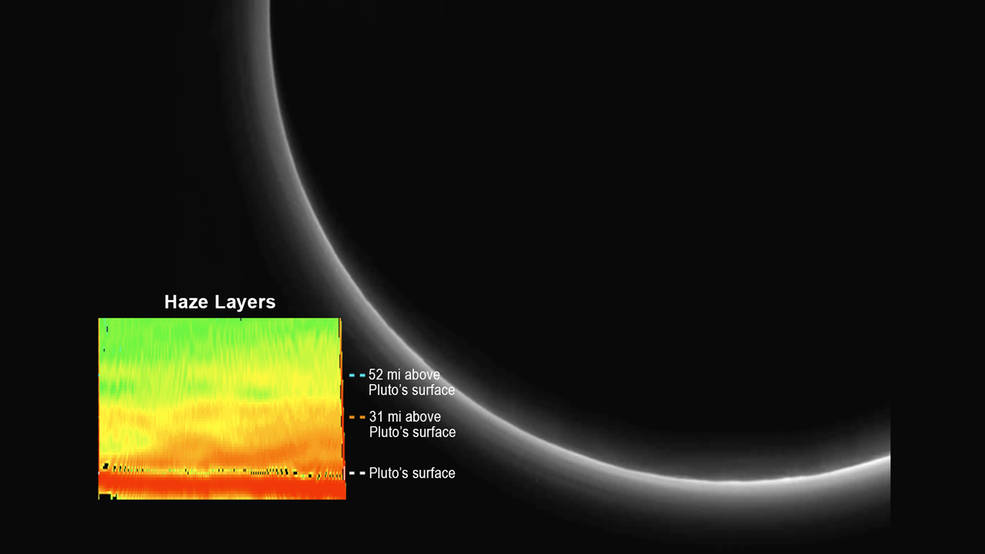
The image below is of Pluto’s silhouette enveloped in its atmosphere, a radiant halo-like ring encircling the dwarf planet. The image is strikingly reminiscent of that of Saturn’s largest moon Titan, taken by the Cassini spacecraft in 2012. This image is what Alan Stern called New Horizons’ equivalent of the "Apollo Earthrise" photo. I couldn’t agree more. What an epic farewell image this was for New Horizons.

8: Pluto’s atmosphere may be undergoing its first stages of collapse
Since 1988, scientists have been taking data on Pluto’s atmosphere via occultations, an event where an object passes in front of a star and blocks the starlight. The amount that the starlight dims, or rather, how it dims, indicates whether the object has an atmosphere, and can be used to infer other information as well.
The trend of the data taken from 1988 through 2013 has appeared to show a linear increase in Pluto’s surface pressure, indicating that the atmosphere was thickening. However, the latest data point taken by New Horizons shows a sudden striking decrease in surface pressures. Looking at the plot below, there is at least a 10 microbar difference between the surface pressure in 2013 and in 2015! To explain what this means in simple terms, there is half as much atmosphere now as there was in 2013!

What does this mean? Well, it could mean that the New Horizons team was right in sending the spacecraft to Pluto as quickly as they did, and caught Pluto’s atmosphere in the nick of time. Pluto’s atmosphere may be undergoing a rapid collapse as it begins to recede into aphelion, its farthest point from the Sun. But we need to wait before making judgements, since this is the only data point taken by New Horizons (all the rest were taken from Earth). Luckily, the SOFIA Airborne Observatory caught an occultation of Pluto sometime in June, so this data will serve as a great way to compare the data taken by New Horizons to that taken by SOFIA. This will allow scientists to interpret the differences (if any) they see in the data taken from the Earth compared with the data taken by New Horizons.
9: Pluto has a heart of ices that flow and mountains some 3,500 meters high, indicating it is a geologically active body
New Horizons touched the world when it revealed that Pluto has a heart on its surface, a region the New Horizons team dubbed the Tombaugh Regio as a tribute to Pluto’s discoverer Clyde Tombaugh. This vast region features a craterless plain full of ices made of constituents like nitrogen, methane, and carbon monoxide. The region is youthful, with an age of no more than 100 million years. While this doesn’t seem young, on a cosmic scale, this region is only about 2.2% the age of the solar system, which is about 4.6 billion years old.
In the Tombaugh Regio, a region void of craters, lies a region called the Sputnik Planum. In the Planum, New Horizons unveiled a region with ices flowing on Pluto’s surface, ices that flow much like the glaciers on Earth do. Yes, that’s right, ices flow on Pluto, a Kuiper Belt Object that’s some 5 billion km (3 billion miles) from the Sun, and a frigid 38 K (-235 C, or -391 F). This is the first evidence that Pluto is a geologically active body. The Planum region is no more than a few tens of millions of years old.
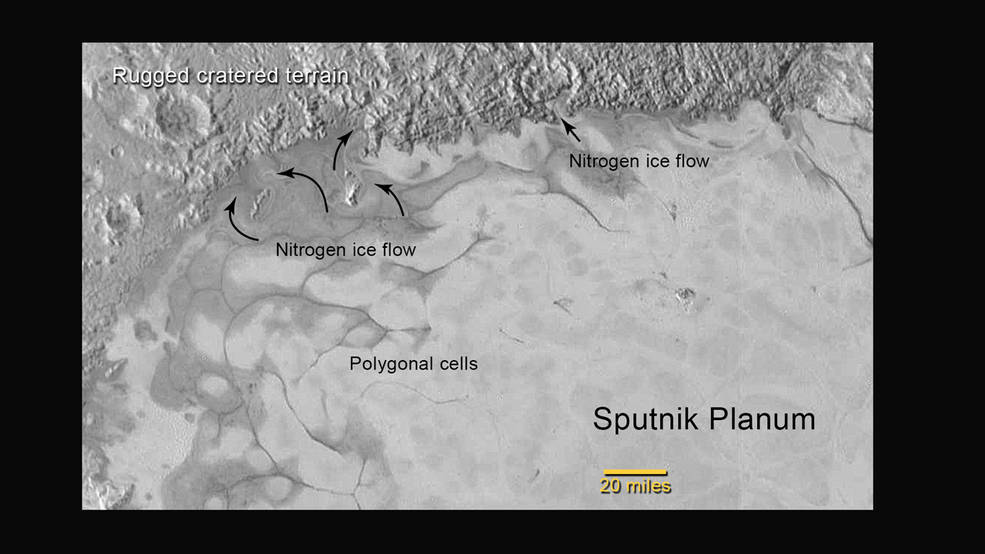
The reason these ices can flow on Pluto’s surface is because the ices in this region are made of nitrogen, methane, and carbon monoxide, and these ices can flow at Pluto’s temperatures (to read more on how this is so, check out my previous Pluto Safari article, here). From this alone, it’s easy to see how diverse the constituents on Pluto’s surface are. You see mountains, meaning these must be made of water ice, since mountains must be made of stuff that’s brittle and hard, not soft and malleable. And you see ices of nitrogen, methane, and carbon monoxide. You see tholins, which give Pluto its reddish color. And there may even be a reservoir of liquid nitrogen beneath Pluto’s surface. More on this will undoubtedly be revealed in the months to come, when the data taken by New Horizons is fully downlinked from the spacecraft.
To the lower left of the Tombaugh Regio, New Horizons brought to light a mountainous region, mountains that reach heights of 3,500 meters (11,000 feet). These mountains are also no more than 100 million years old, and probably continue to form today. Like the Tombaugh Regio, this region is void of craters, which indicates that some ongoing process has erased them.

10: Pluto’s surface variations are pretty uniform going from its equator to its poles, except for one strikingly different area—the Tombaugh Regio
The enhanced color image of Pluto is not only stunning, but also reveals that Pluto’s surface composition and texture varies with latitude. At the equator, you see the darkest region of the planet, the reddish hue that is likely caused by the tholins that are produced in Pluto’s atmosphere. Moving to the poles, the area becomes very bright, and is likely so due to ices. We know that Pluto has an eccentric orbit about the Sun, one that brings Pluto as close as 30 AU from the Sun at its closest, and as far as 50 AU at its farthest. The north pole is also tilted by about 120 degrees to its orbital plane. These factors probably cause Pluto’s equator to get "baked" by the Sun, while leaving icy deposits at its poles. But yet, one striking region on Pluto stands out and does not follow the same latitudinal variations—the Tombaugh Regio. This region may be a source region for the ices found on Pluto. You can view the enhanced color image below.

There is much we have learned about Pluto since New Horizons’ historic flyby of the dwarf planet on July 14th, 2015. And this is just the beginning, with only 5% of the full dataset downlinked so far. Once all the data is received and analyzed by the New Horizons scientists, there are sure to be many more surprises and some amazing discoveries.
 Sophia Nasr is an astrophysics student at York University. Actively involved in the astronomical community at York U, she is the President of the Astronomy Club at York University and a member of the team at the York University Observatory. She also is involved in university projects, and holds a position in research on dark matter at York U. Holding scientific outreach dear, Sophia is actively involved in social media outlets such as Facebook, Twitter, and Google Plus, where she shares with the world her passion for the universe and how it works.
Sophia Nasr is an astrophysics student at York University. Actively involved in the astronomical community at York U, she is the President of the Astronomy Club at York University and a member of the team at the York University Observatory. She also is involved in university projects, and holds a position in research on dark matter at York U. Holding scientific outreach dear, Sophia is actively involved in social media outlets such as Facebook, Twitter, and Google Plus, where she shares with the world her passion for the universe and how it works.







